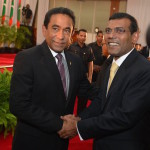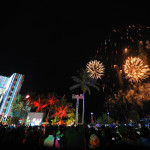Alifushi island in Raa atoll has still not received emergency water after the last batch was found unsuitable for drinking.
The council’s tests through the island health center indicated there were bacteria and dust in the water which is currently being tested by Environment Protection Agency (EPA).
Alifushi council President Abdul Latheef said that no water have been delivered to the island since the incident, and that people were depending on bottled mineral water bought from local shops.
While the National Disaster Management Center (NDMC) stated the island authorities had not requested more water, Alifushi council said that they should receive a replacement for the contaminated batch without having to ask.
Seasonal water shortage
Meanwhile, the NDMC has said that 34 islands have requested a total of 2,639 tonnes of emergency water following water shortages this year. Water has now been delivered to sixteen of these islands.
Water shortages have become a seasonal issue, with 53 islands requesting water between February 3 and April 25 last year, with similar numbers in previous years.
While no research have been done as to what causes the water shortage, it has been suggested that it is due to the contamination of ground water following the 2004 tsunami.
Traditionally, rainwater when collected is used for drinking as well as water from ground wells. Ground water was also used for cleaning, cooking, and other purposes. Every year during the dry period – particularly from February to April – a number of islands request emergency water.
Stating that the impact of the tsunami on the island was relatively small, Latheef blamed a lack of effective sewage system and having to dispose sewage effluent into ground for the water contamination.
“The population is not small here. For years we have been given the good news of a sewage system. Eight times, I remember,” he said.
Lateef said that just last week a research team from Maldives Water and Sewerage Company (MWSC) came to island.
“We have seen so many teams and research being done. But I have no hope that it could actually happen”.
Government response
According to NDMC, the water is bought from MWSC and is then collected from the nearest desalination plant and delivered to the islands by private companies on contract bases.
The councils then sign and approve the water before it is transferred to public water tanks. The NDMC buys the water from special funds allocated by the Ministry of Finance, with no specific budget allocated for this purpose.
The Alifushi Council president said that the island has a desalination plant gifted to local NGO ‘Vadinge Ekuveri Jamiyyaa’ by the UNDP, though the plant was later handed over to the state-owned FENAKA utility corporation.
“If the council had that plant, we would be producing water right now. But FENAKA has not produced any water for the past two years,” Latheef said, adding that FENAKA produced and distributed forty litres of water daily for every household until they stopped.
When contacted by Minivan News, FENAKA explained that the only person authorised to talk to the media was the managing director who would require a written enquiry.






I dont believe this is an emergency but rather a mix of poor water management and conservation, confusion over responsibility and lack of community spirit. You dont plan for disasters and yet the NDMC and govt plans for this 'water shortage emergency' each year. The govt paid over 7 million rufiyaa in 2009 for this. and its been happening since 2004 tsunami. i think its high time we found a permanent and more sustainable solution for this issue rather than spending millions of tax payers money on transporting water